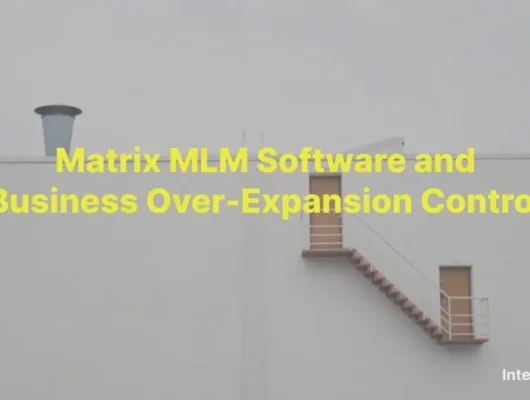Multi-Level-Marketing (MLM) is also known as Network Marketing, Referral Marketing or Direct Marketing, and involves Sales Representatives (a.k.a. Distributors, Affiliates, or Associates) advertising the company products to end customers and receiving commissions from it.
Table of Contents
Core Features of MLM
The exact origins of Multi-Level Marketing (MLM) are disputed, but the first MLM businesses in the 1930s were California Vitamin Company (later Nutrilite) and the California Perfume Company (now Avon Products).
The distributors can either be employees or independent contractors. Typically, a self-employed, unsalaried, and independent MLM distributor is entitled to earn money in two ways.
- Firstly, by selling branded products of the company ‘directly’ to consumers by advertising or marketing them.
- Secondly, by recruiting, training, and motivating new distributors to build a so-called ‘downline’ of members. The recruits, in turn, recruit more people resulting in a ‘hierarchy’ of recruiters/sellers. This helps in fast recruitment and rapid growth in market presence.
The career growth progresses through levels like Silver, Gold, etc., culminating in the President’s Club based on achieved sales targets. The complexity of sales processes across different levels makes traditional pen-and-paper tracking impractical, necessitating the streamlining provided by a Multi-Level Marketing Software.
MLM Compensation Plans
Compensation plans are how companies reward distributors for sales and recruitment. Alongside compensation, distributors gain entrepreneurial exposure and skill development with minimal investment.
- Uni-level Plan : Basic structure where recruits are placed directly under their recruiter, earning commissions based on downline sales volume.
- Binary Plan : Distributors recruit two others and earn commissions based on the weaker leg’s performance, requiring balanced growth in both legs.
- Matrix or Forced Matrix Plan : A Matrix has a set width and depth. New matrices are initiated once positions are filled in the old.
- Stairstep Breakaway Plan : Once a distributor achieves predefined personal or group volume, they move up a commission level.
- Hybrid plans : Combines elements from other plans for flexibility and customization.
A customizable MLM software like Integrated MLM Super App provides comprehensive promotion and payment solutions, reducing human errors and distributor distrust in the compensation methods.
How MLMs Charm the Customers
MLMs are attractive in the following ways:
- Customers prefer personal connection with brands, ensuring trust, reliability, and approachability. MLM facilitates two-way communication between brands and customers through distributors.
- Direct purchasing offers security against knock-offs, leading customers to prefer direct marketing despite higher prices.
- Distributors in MLMs welcome and address direct customer feedback, unlike traditional marketing channels. An MLM software can help register direct feedback and utilize it effectively.
- MLM allows brands to collect extensive business data from distributors, unlike retail purchases, where brands lack complete sales information. Integrated MLM Software ensures secure collection, storage and processing of customer information.
- MLM maintains brand continuity throughout the marketing chain, avoiding compromises to brand image by involving a retail marketer for market reach.
- MLMs thrived during market disruptions like the 2020 shutdown by quickly adopting online purchasing and no-contact delivery options compared to brick-and-mortar businesses.
Traditional business models v/s MLM
- Traditional business models operate within brick-and-mortar establishments, relying on intricate supply chains and centralized decision-making structures. In contrast, Network Marketing is driven by everyday people, featuring a flatter hierarchy for swift decision-making by distributors.
- Traditional businesses can offer professional services requiring expertise whereas MLM markets a selected basket of products and stick to basic marketing techniques that do not mandate any fancy degrees.
- Traditional businesses bootstrap themselves with minimal external investment or seek bank loans, bearing significant initial capital and industry-specific risks. MLM requires minimal investment, primarily product purchases by distributors, but faces high dropout rates, (a minimum of 50% of representatives drop-out in the first year of operation) as Taylor’s research indicates.
- In response to the rise of e-commerce and digital marketing platforms, traditional businesses are increasingly leveraging these tools to bolster their online presence. They are gradually adopting “omnichannel strategies,” which involve synchronizing online and offline inventories, offering in-store pickup options for online orders, and utilizing mobile applications to provide a seamless customer experience across all customer touch points.
- Network marketing, however, is a disruptive business strategy which has already examined and exploited innovative business channels to reach customers directly such as the E-Commerce MLM Companies. Their swiftness and steadfastness stand a challenge to the traditional business models.
- Traditional business models excel in market predictability, stability, and sustainability. They optimize existing processes, improve efficiency, and deliver incremental improvements within an established market. Therefore, they typically carry lower risk levels by operating within established market frameworks, leveraging existing customer demands, and utilizing known business practices.
In contrast, Network Marketing introduces disruptive concepts, facing uncertainty and higher risk due to market resistance and the need for acceptance and adoption.
Products that excel in an MLM model
The MLM’s rapid growth and success stems from filling a significant gap in economic and business functions. Through direct selling, marketers can provide consumers with extensive information, surpassing the limitations of traditional advertising and retail distribution.
The age-old advertising conveys only limited information to the customers, and often, the retail store staff may lack in-depth product knowledge. Thus, innovative and groundbreaking products that struggle in the traditional channels find visibility through MLM. These products may already have an independent reputation outside the MLM (e.g., health products). Direct selling also facilitates obtaining valuable customer feedback, promptly incorporated into operational loops for product improvement and innovation.
Understanding Why Many MLMs Falter
Numerous multi-level marketing (MLM) firms generate annual revenues in the billions and annual profits in the hundreds of millions of dollars. However, the following factors contribute to why a large chunk of them fail:
- Focus on recruitment to earn income rather than retail product sales, making the MLM resemble a Ponzi scheme or an illegal Pyramid Scheme. Utilizing an MLM application can ensure recording sales and recruitment volumes within regulatory guidelines.
- Unfair compensation plans where a larger chunk of commissions goes to the top levels of the hierarchy.
- Unrealistic “get-rich-quick” promises made to distributors, which erode away once they start working. Research by Dr. Jon Taylor argues these false promises deliver losses “to all but those at or near the top of a large pyramid.”
Lack of compliance with legal and ethical regulations in place. Though banned in a few countries such as Bangladesh, China, and Saudi Arabia, MLMs thrive in most other parts of the world, including all 50 states of the US.
Conclusion:
Despite the various challenges that the Network Marketing industry faces, it is undoubtedly a rapidly growing disruptive marketing model, expected to reach $300 billion by 2030 according to Zion Market Research. By managing business operations from onboarding to compensation plans with the help of the Integrated MLM software, navigating this difficult landscape of Network Marketing easily acquires incomparable comfort.





